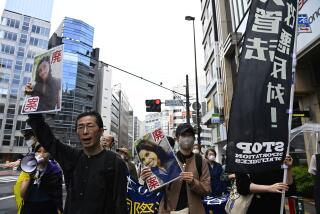Japan’s Banking Mess: Inmates Run the Asylum
- Share via
TOKYO — If you wonder what’s taking Japan so long to solve its banking crisis, consider some of the folks responsible for cleaning up the mess.
For 11 years, Akihiro Shimomura urged his customers at Cosmo Credit Cooperative to borrow and borrow and borrow. But when the bank collapsed two years ago under a mountain of bad loans that it should never have made, Shimomura switched sides. He joined the government agency charged with trying to recoup the losses.
He’s not alone. The bulk of Shimomura’s colleagues at the Resolution & Collection Bank also are veterans of the 38 Japanese banks and credit unions that have gone bust in the last few years.
Some observers wonder if, in trying to bail itself out of a banking crisis, Japan is merely shuffling the deck chairs on the Titanic.
“It’s the same players, just changing the name on the door,” says Elizabeth Daniels, a banking analyst at Morgan Stanley Japan Ltd. in Tokyo.
Japan’s lack of independent, experienced people at such a pivotal agency is just one of the myriad problems hindering efforts to rid banks of the up to $1 trillion in bad loans that is choking them.
Even as the international spotlight shines on the bad debt that is being blamed for stifling Japan’s huge economy, only a tiny chunk of the loans have been sold or written off in the last few years.
There is also the well-known problem of the yakuza--Japanese gangsters--refusing to relinquish their many properties. But that is far from the biggest obstacle.
A more important one: The Japanese collection bank is impotent compared with its U.S. counterpart, the Resolution Trust Corp., which was given far more power in cleaning up America’s savings and loan debacle in the early 1990s.
Only now is Japan’s parliament considering legislation that would enable its cleanup agency to hire private firms to dispose of the loans, package them for sale in bulk and make it easier to auction off properties.
In contrast, the U.S. agency was essentially a liquidator: It closed banks, advertised trophy properties with glossy brochures, hired private firms to sell the real estate and offered incentives to salespeople to move the properties quickly.
“The power of the RTC was pretty absolute: They walked in, shut down banks, got rid of the staff” and sold off the properties quickly, says J. Brian Waterhouse, an analyst at HSBC Securities Ltd. in Tokyo.
But the Japanese agency cannot close institutions--that is the prerogative of a newly created, equally inexperienced government body known as the Financial Supervisory Agency. Nor can the collection bank confiscate property automatically. On average, it takes two to three years to get rid of each problem loan, the agency says.
More problematic still is that the agency can’t actually sell properties that were used as collateral for loans that went bad: The debtors still theoretically own them.
Thus, the Resolution & Collection Bank can refer prospective buyers only to the original borrowers. “We can sell only when the debtor is willing to sell,” says Toshihiko Sato, a manager on loan, so to speak, to the collection bank from the Bank of Japan. “The owner normally finds the buyer.”
Only when the debtor has made no payment for six months can the agency push to sell the property at auction, unlike the more powerful RTC, which could sell any way it pleased.
The slow pace of the bad-loan disposal frustrates foreign firms that have descended on Tokyo looking for bargains. Jack Rodman, Asia director for Los Angeles-based E&Y; Kenneth Leventhal Real Estate Group, has had no luck getting the Resolution & Collection Bank to let him do bulk sales of their bad properties.
Selling off all the bad loans would stimulate Japan’s moribund economy, Rodman contends. The banks, which made huge loans in the heady bubble economy days of the 1980s, when Japan’s real estate market was prospering, are now sitting on loans backed by collateral worth far less than the money owed, thanks to a property market that nose-dived in the ‘90s. Some properties have sat around for seven years with no payments or occupants, Rodman says.
*
Even if the loans fetched a mere fraction of their original value, it would stir things up: New buyers would begin making repairs and renovating properties, he says. The new owners could slash rents because they picked up the idle office space at a low price.
Further complicating the endless process are the multiple liens attached to most collateral properties. Many creditors often have claims on the same property: A borrower might use the same building as collateral for several loans--perfectly legal in Japan.
“If Japanese banks were issuing loans to each project, and not each company like in the U.S., we wouldn’t be in this trouble to begin with,” says the collection bank’s Sato.
Japanese banks themselves have been reluctant to get rid of their bad loans, clinging to the notion that the property market will revive. Moreover, reducing their assets--which are their outstanding loans--means they would have to come up with more capital to meet regulatory minimums that many barely satisfy now.
The banks contend that most of the $620 billion they have disclosed in possible problem loans might be recoverable. Many analysts think the amount may run to $1 trillion or more.
The Resolution & Collection Bank hasn’t handled anywhere near either amount: It deals only with the bad loans of the six banks and 32 credit cooperatives that have actually collapsed in Japan in the last two years. At the end of the last fiscal year, March 31, the collection back had raised only about $612 million from sales of bad loans.
Japan’s surviving banks have set up their own agency to handle the disposal of their worst loans. Known as the Cooperative Credit Purchasing Co., it has yet to make much headway, either.
Prospective buyers must come to the agency to peruse a 115-page computer spread-sheet printout listing available properties by address, size, location and price per square meter. Interested buyers are then referred to the banks themselves.
“We’re in the Stone Age here,” analyst Daniels says. “Why can’t they sell it at Yaohan [a supermarket] or on the Internet?”
Still, other experts argue that the U.S., which has lambasted the slow speed of the Japanese in tackling their financial problems, is hypocritical.
“There might be a lot of transparency problems in Japan, but the U.S. model is no model at all,” says Jonathan A. Scott, a Temple University professor who was a regulator in Texas during the S&L; crisis.
The key question in valuing such loans, in Japan as in the U.S. crisis, is correctly assessing what a property is worth in the market. There were plenty of disputes during the U.S. crisis about the underlying collateral values, just as there are in Japan.
In Japan, groups of employees from each failed bank join the collection bank and are assigned to recover the problem loans made by their former employers. The collection bank’s Sato explains the reasoning: These former employees know the clients, so they are better able to work with them, since so much of Japan’s business culture is built around time-honored relationships.
But Shimomura, the former loan officer at the failed Cosmo credit union, says these personal connections are actually a hindrance. Debtors are less likely to pay--and more likely to be critical--when they realize the collection agents are their former bankers.
It’s a stressful job--made worse by the knowledge that once these collection agents resolve all of the bad loans, they will once again be out of jobs. Thus, there’s an incentive to move slowly.
Shimomura, however, prefers to look on the bright side. He says he is learning a lot.
“All I can do is do the best job possible,” he says, adding that there appears to be a future in Japan for those in the business of collecting bad debts.
*
Etsuko Kawase of The Times’ Tokyo bureau contributed to this report.
More to Read
Sign up for Essential California
The most important California stories and recommendations in your inbox every morning.
You may occasionally receive promotional content from the Los Angeles Times.













